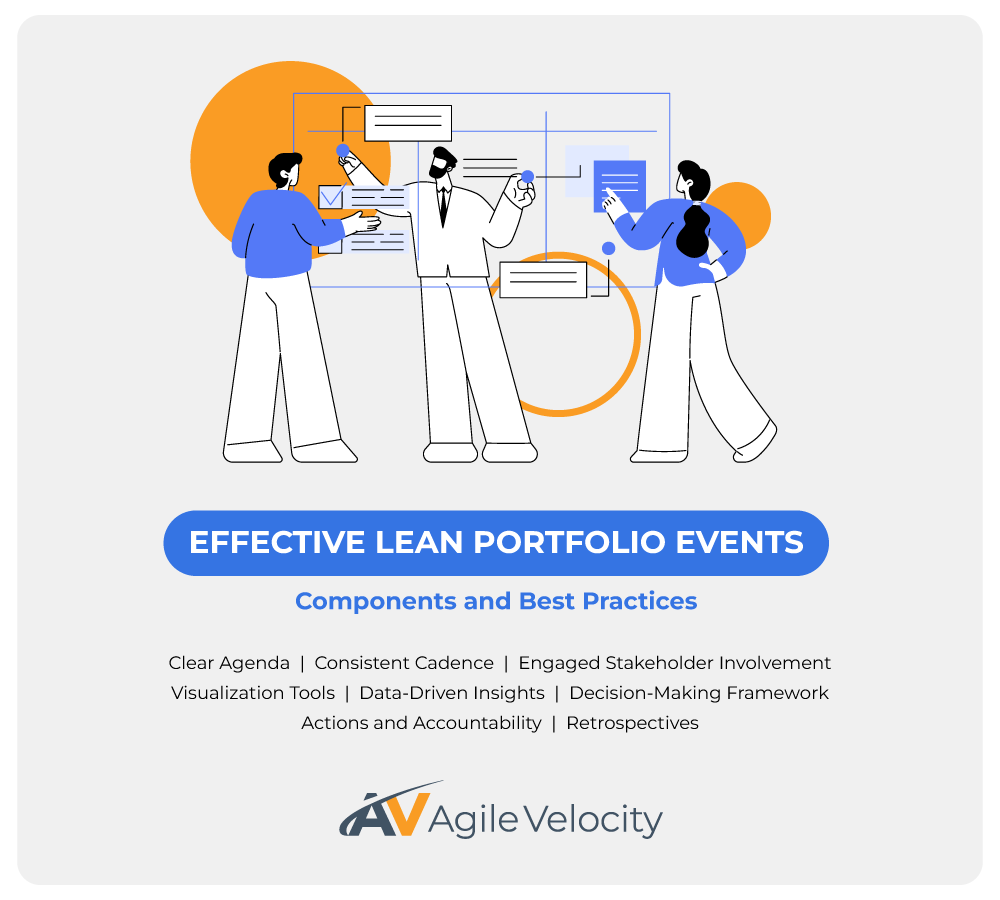Lean Portfolio Management provides organizations with a framework to improve alignment, optimize value delivery, and reach strategic objectives by focusing on value streams, frequent feedback loops, and open transparency. These continuous feedback loops help teams address obstacles early and adapt to shifting priorities for ongoing success.
In this article, we’ll explore actionable strategies to structure portfolio-level events that strengthen Lean Portfolio Management practices, improve organizational agility, and enable outcome-focused growth.
Whether you’re just starting an Agile Transformation or guiding established teams, these insights can help your organization streamline portfolio management and deliver value aligned with evolving business needs.
Overview of Lean Portfolio Management
Lean Portfolio Management applies Lean principles—such as eliminating waste, optimizing flow, and embracing short feedback cycles—to the portfolio level. Rather than relying on rigid, long-term plans, organizations regularly reassess priorities in smaller increments, adapting to new information. This nimble approach maximizes value by addressing issues early and aligning teams on the most important objectives.
A vital concept here is the value stream: the end-to-end flow of activities that deliver business outcomes. By focusing on these streams, organizations expose inefficiencies and can channel efforts toward impactful projects. Various scaling frameworks, such as SAFe®, or methods like Large-Scale Scrum (LeSS), can be used depending on context. These approaches support broader Lean practices at the portfolio scale.
Structuring Portfolio Events for Lean Portfolio Management
Aligning multiple projects, products, and departments around shared goals is a constant challenge. Many organizations face competing priorities, which can result in fragmented focus, unpredictable delivery and delays. Structured portfolio-level events help solve this problem. By scheduling recurring sessions dedicated to prioritization, teams can stay focused on the right work, refine objectives when necessary, and address bottlenecks before they grow too large.
Such events bring stakeholders together to clarify strategic directions, ensuring the organization’s resources are devoted to the highest-value efforts. A regular cadence of discussion promotes open communication and rapid decision-making, fostering quick responsiveness to change. This shared focus builds a culture of adaptability and continuous value delivery.
Objectives of Portfolio-Level Events
Portfolio-level events serve as powerful checkpoints to align stakeholders, understand constraints, and shape future actions. When planned and executed effectively, they fulfill three essential goals:
Align Stakeholders on Shared Goals and Organizational Priorities
Events unite diverse groups—technology, business, and finance—to discuss organizational aims. By clarifying strategic objectives, teams develop a cohesive vision, reducing confusion about where to apply time and budget. This helps build momentum toward common outcomes and prevents siloed efforts.
Prioritize Initiatives Based on Value Delivery and Resource Availability
Reliable, data-driven prioritization keeps organizations flexible. Priorities are evaluated according to impact, return on investment, and feasibility. This ensures that essential projects receive focused energy, prevents wasted work, and keeps leaders informed about pressing needs.
Promote Transparency and Build Trust Across Teams and Leadership
Transparent discussions about project progress, risks, and potential roadblocks foster greater trust. Clear ownership for each initiative allows for straightforward follow-up and accountability. When participants understand how their efforts feed the broader mission, they are more likely to remain engaged and supportive of decisions that emerge from these sessions.
Essential Components and Best Practices for Effective Portfolio Events
Structured portfolio-level events thrive on a well-balanced combination of planning, execution, and review to continuously enhance value across an organization. A strong framework for these events typically includes clear agendas, defined roles, and established metrics to monitor success. Such preparation ensures that each session is productive, aligns with strategic goals, and facilitates actionable outcomes that drive organizational improvement.
To deliver value, portfolio-level sessions must be thoughtfully designed. Typically, productive events include:


A Clear Agenda
Define the purpose, timeline, and target outcomes before the session. A well-structured agenda keeps conversations tightly focused.
Consistent Cadence
Hold sessions at regular intervals—monthly, quarterly, or otherwise—so everyone knows when to expect these discussions and can make time for them well in advance. The interval should allow enough time for measurable progress while preventing long stretches with no alignment check-in.
Engaged Stakeholder Involvement
Include participants who can speak for different aspects of the organization, such as senior leadership, financial planning, technology, or Product Managers. Ensuring the right voices in the session leads to meaningful dialogue about capacity, market demands, and strategic direction.Be sure to make expectations clear to all participants so that they come to meetings well prepared.
Visualization Tools for Clarity
Leverage simple, visual boards or dashboards to illustrate the relationship between projects, dependencies, and milestones. A quick view of the entire portfolio helps stakeholders make decisions faster and see emerging problems before they escalate.
Data-Driven Insights
Bring metrics and financial milestones to ground discussions in evidence. This minimizes guesswork and frames decisions around real indicators of progress.
A Structured Decision-Making Framework
Applying scoring models or techniques like Weighted Shortest Job First (WSJF) can reduce the influence of personal bias by standardizing criteria for evaluating projects. This consistency fosters a portfolio that aligns with tangible value and urgency.
Concluding with Actions and Accountability
Each session should produce a list of next steps that are tied to strategic goals. This ensures that events transform into tangible progress rather than open-ended dialogue. Ensure you record who is responsible for each piece of follow-up, along with a realistic timeline for delivery. Defining responsibility drives follow-through and shows the organization’s commitment to improvement.
Retrospectives for Continuous Improvement
Even portfolio events benefit from a short retrospective. Gather feedback on the flow of the session, clarity of objectives, and stakeholder engagement. Make small adjustments in response. Over time, these refinements can significantly improve effectiveness.
Transitioning from Traditional to Agile Portfolio Management Approaches
Traditional portfolio management often hinges on fixed annual planning cycles and detailed upfront approvals. These processes can struggle in environments full of shifting requirements, leading to delayed decisions or missed market opportunities. In contrast, an Agile approach invites frequent reassessment where teams respond quickly to new insights.
A phased approach to incorporating Lean Portfolio Management can help. Instead of overhauling the entire system at once, start with a pilot. Apply shorter planning increments and cross-functional sessions on a small portion of the portfolio. Document successes, such as improved turnaround or more satisfied stakeholders, and communicate them up the chain. As people see positive results, they become more open to expanding Agile practices more broadly.
This shift isn’t purely procedural. Adopting an iterative portfolio strategy requires open communication, reevaluating old habits, and a willingness to embrace dynamic objectives. Their research underscores that organizations often see benefits like improved forecasting and better transparency after moving away from plan-driven methods.
Embracing Lean Management and Agile
Questions sometimes arise about choosing between Lean management or Agile frameworks. Some leaders fear that mixing these approaches could complicate collaboration. However, combining Lean with Agile can amplify benefits, particularly at the portfolio level.
Lean management introduces a culture of waste reduction, efficient flow, and tight process discipline. Agile promotes adaptability, short cycles, and fast feedback loops. Together, they encourage organizations to pursue continuous improvement while retaining the flexibility to pivot in response to shifting market demands.
In large enterprises, teams often handle an array of initiatives, each requiring a mix of Lean efficiencies and Agile responsiveness. For instance, your technology unit might manage Kanban boards to control work in progress. Meanwhile, business stakeholders could focus on iterative planning events to set short-term goals. At the portfolio level, Lean methods keep overall processes streamlined, while Agile practices let individual teams adjust rapidly without derailing the entire roadmap.
Watch the video below to learn more about applying lean budgeting to simplify financial processes:
Leadership involvement is crucial here. Senior executives who understand how Lean and Agile reinforce each other can align budgets, resource allocations, and strategic goals accordingly. They periodically host events dedicated to reviewing portfolio flow, seeking insights from Lean metrics, and gauging Agile maturity at the team level. These gatherings offer a holistic vantage point from which to drive sustainable improvements.
By embracing both approaches, organizations can adapt to shifting circumstances, maintain process discipline, and deliver consistent value. Lean Portfolio Management becomes a unifying framework that leverages the strengths of each methodology. This connection ensures a more robust system that is better able to respond to new priorities without sacrificing efficiency or quality.
The Role of Agile Coaching in Lean Portfolio Management
Agile Coaching can accelerate the adoption of Lean Portfolio Management. Coaches guide teams through new practices and offer training or facilitation, but more importantly, they shape mindsets that support thriving in fast-evolving environments.
Coaches help integrate roles across the organization, bridging gaps between senior leaders, finance, technology, and marketing teams. Rather than imposing one rigid methodology, a good Agile coach focuses on cultural shifts that help teams solve unique challenges. The result is a self-sufficient environment where Lean Portfolio Management becomes second nature, leading to sustainable outcomes over time.
The Impact of Structured Portfolio Events on Organizational Agility
By holding recurring sessions, organizations maintain a laser focus on delivering customer-centric value. Frequent alignment reduces the risk of investing in outdated goals. It also fosters cross-team awareness. When finance spots technology challenges early, for instance, they can adapt budgets or approvals without causing bottlenecks later on.
Regular portfolio events mitigate silos, boosting knowledge sharing and respect for constraints across departments. Over time, people see how accountability and transparency produce better products and services. This consistent dialogue ensures strategic direction influences day-to-day decisions, closing any gap between planning and execution.
Build High-Performing Teams
Continuous Improvement Strategies for Portfolio-Level Performance
Continuous improvement is fundamental to Lean Portfolio Management. Adapting incrementally helps teams handle complexity more confidently. After each session, gather feedback and assess whether the event design, stakeholder roles, and prioritization frameworks are delivering the outcomes you expect.
Periodically, share success stories and hard lessons. Organizations that practice open learning tend to evolve their Lean portfolios more effectively. When best practices and lessons are transparent, teams feel motivated to adopt them. This reinforces a culture of experimentation and shared ownership.
Unlocking the Potential of Lean Portfolio Management

Structured, recurring events are a pivotal asset in Lean Portfolio Management. They provide the open forum teams need to recalibrate priorities, resolve impediments, and sustain strategic alignment. Paired with the right tools and experts who can provide invaluable guidance, these sessions turn dialogue into immediate, measurable results while building trust through transparency.
Frequent and well-organized portfolio events form the bedrock of any enterprise aiming to deliver consistent value. If you’d like more details on how to refine these processes, explore our Lean Portfolio Management service offering. If you’re ready to transform your portfolio management approach, reach out to Agile Velocity today for expert coaching guidance. We’re here to help you unlock lasting benefits from effective Lean Portfolio Management.



